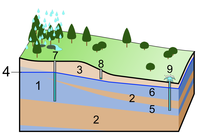
Photo from wikipedia
Conserving coldwater stream ecosystems in a warming world requires understanding how water temperature changes will affect the sustainability of coldwater fish populations such as brook charr (Salvelinus fontinalis). To date,… Click to show full abstract
Conserving coldwater stream ecosystems in a warming world requires understanding how water temperature changes will affect the sustainability of coldwater fish populations such as brook charr (Salvelinus fontinalis). To date, many models for predicting stream temperature have either assumed spatially uniform (inaccurate) air-stream temperature relationships or required expensive measurement of hydrometeorological drivers (e.g., solar radiation, convection) in a manner impractical for fisheries management. Hence, we developed an accurate, cost-effective, management-relevant modeling approach for projecting how changes in air temperature, precipitation, and groundwater inputs will affect coldwater stream temperatures and brook charr survival and growth in Michigan, USA. Precipitation- and groundwater-corrected models predicted stream temperatures more accurately than air-stream temperature models. Projected stream warming intensified in proportion to simulated air temperature warming and was most extreme in surface runoff-dominated streams with limited groundwater-driven thermal buffering. However, groundwater-dominated streams will not invariably provide sufficient coldwater habitats for brook charr survival and growth if groundwater temperatures increase or groundwater inputs decline due to reduced precipitation. Amid resource limitations, fisheries managers can use the stream temperature modeling approach described herein to predict effects of climate change on brook charr survival and growth and take actions to facilitate their sustainability in riverine systems.
Journal Title: Hydrobiologia
Year Published: 2019
Link to full text (if available)
Share on Social Media: Sign Up to like & get
recommendations!